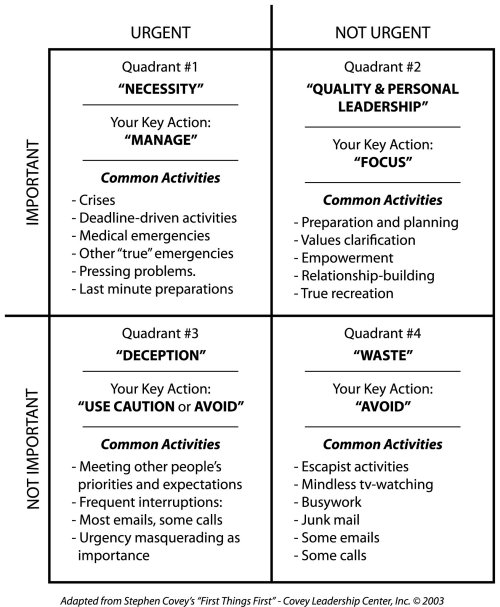Covey Time Management -
Busting Loose of Time Wasters!
Applying the 4 Quadrants of Covey time management is a fabulous tool that helps us visualize commitments, and become strategic with re-assessing and re-prioritizing them. Without a strategy, writing down everything as a to-do list, is just mind-dumping without order. It doesn't actually help us sort-through what's next.
Additionally, even with a clear list or plan, life throws us curve-balls. Things do come up! But, do these surprises always 'require' our immediate attention? How do you assess what's really important?
Well, it's all very workable with the Covey time management 4 Quadrant activity. This exercise helps us to assess the "urgency" of something, to determine if it really needs our attention.
Making the 4 Quadrants Work
Steven Covey's 4 quadrants divides into the following 4 categories:
· Quadrant 1: Urgent & Important
· Quadrant 2: Not Urgent & Important
· Quadrant 3: Urgent & Not Important
· Quadrant 4: Not Important & Not Urgent
The chart below displays how to use the 4 quadrants. When writing out your to-do list, each task should be assigned to a quadrant, which instantly helps you see your priorities.

Applying the 4 Quadrants to
Your Time Management
Need more clarification on each quadrant? Here's how we think they're used best. Note that writing in each quadrant is important. Be honest with placement and prioritizing of the tasks that drain your personal energy.
Quadrant 1: Important, Urgent Quadrant - Immediate priorities. This is a more stressful quadrant to 'live-in.' These are your priorities. Each day, you'll want to list these out as the first items to tackle. The reality is that these items often don't require that much time, and solutions require swift immediate action. If we just get these done, we experience with less stress and anxiety, and greater freedom to genuinely relax. Also, there may be only a few items that require your pressing attention.
Tip for Quadrant 1: Think about it, how many real emergencies do you really have each day or week? Be careful of what's you define as an actual emergency. It's easy to make other people's problems our emergency! Often times, quadrant 1 'emergencies' are entirely preventable if we planned more wisely.
Quadrant 2: Important & Not Urgent - Upcoming priorities that allow for thoughtfulness and planning. I believe that our most meaningful tasks belong in quadrant 2. These items are coming-up, and we can easily handle them while they're small. The good news is that applying effective time management tips can help make these tasks manageable. Taking small, calculated steps creates progress and improved well-being simultaneously.
Tip for Quadrant 2: Procrastinating on quadrant 2 tasks can easily make them quadrant 1 emergencies. Handle them while they're small to feel in-control, clear, and confident about your schedule.
Quadrant 3: Not Important & Urgent - The drama quadrant. Who's emergency is this anyway? Have you ever heard the quote, "Your lack of planning is not my emergency?" Well, that describes this quadrant pretty well. This is a quadrant for drama, and can be a major energy waster. You'll need to be highly cautious when circumstances arise in this area. Think about it this way, if you woke-up each morning with 50 coins of energy that are irreplaceable, which quadrant would you want to use them in each day? It's easy to be drawn to other people's problems, be the helper, problem solver, and more. It's also easy to get 'excited' about something that's doesn't require that much attention, and several of your energy coins go down the toilet alongside your progress.
Tip for Quadrant 3: Ask yourself this,...when you're on high alert in quadrant 3, whose handling your business?
Quadrant 4: Not Important, Not Urgent - The distraction and procrastination area. These tasks are better known as distractions. If you procrastinate often, you may know this quadrant all too well. Activities that fall in quadrant 4 thwart meaningful progress, much deserved rest, study time, or homework. These are major time wasters such as watching TV too many hours, gossiping, spending hours on a social media website, or mindlessly being yanked from task to task without feeling in control.
Tip for Quadrant 4: The solution to this quadrant: plan for down-time. If you love watching tv, great! Be sure to watch or record your 'favorite' shows, set a 15 minute timer for social media, and have 'unscheduled' time for being spontaneous. Because most things that 'end-up' here become time wasters don't serve you. Think about it - Do you ever really feel good when you've wasted time? It's much better to make room for your fun, rest, and downtime each day, so you're not feeling like a quadrant 4 zombie!
Be sure to visit other great resources on this site, such as learning your Time Manager Type and apply the Covey time management quadrant to overcoming procrastination as well.
Home > Franklin Covey Time Management > Covey Time Management 4 Quadrants